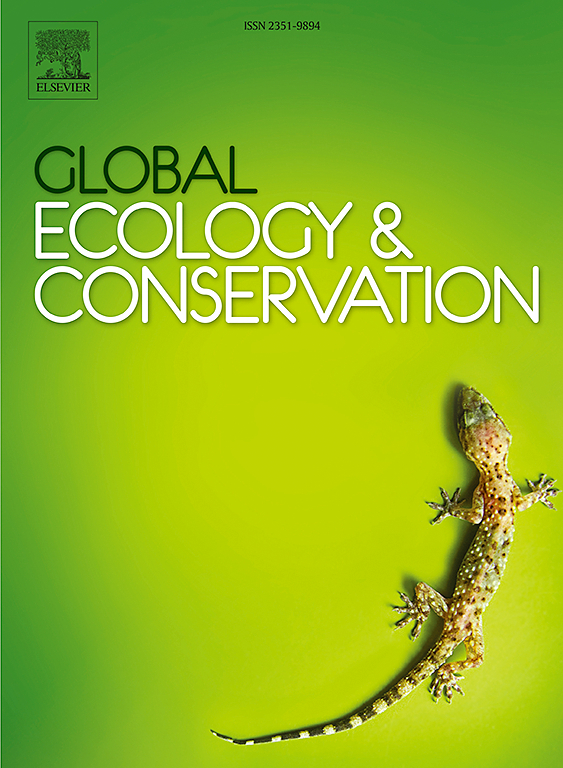喀斯特生态系统中主要树种朴树的土壤特性和叶片特征对石漠化的反应
IF 3.5
2区 环境科学与生态学
Q1 BIODIVERSITY CONSERVATION
引用次数: 0
摘要
石漠化是喀斯特地貌普遍面临的环境挑战,阻碍了地区的可持续发展。了解土壤特性和植物性状如何应对日益严重的石漠化对制定有效的恢复策略至关重要。在这里,我们研究了岩溶生态系统中石漠化梯度的土壤特性和中华假杉的种内叶片化学计量特性。我们采用主成分分析法评估土壤特性和叶片化学性状的变化,并利用叶片性状网络分析法探讨性状网络拓扑结构的变化。我们的研究结果表明,严重荒漠化地区的土壤容重和pH值较高,可利用的氮、磷、镁和土壤有机碳含量较低。叶片的化学计量沿梯度发生了明显的变化,退化地的氮素限制和阳离子失衡程度升高。性状网络分析显示,随着岩石荒漠化的加剧,网络直径和模块化程度增加,而连通性降低,这表明性状之间的整合程度降低。另一方面,在中等程度的石漠化条件下,土壤对恶劣环境的适应能力较强。这些发现表明,土壤特性和叶片性状在岩石荒漠化梯度上都会发生重大变化,随着退化的加剧,功能破碎化和养分限制也会加剧。根据研究结果,我们提出了针对不同石漠化程度的管理策略,以减轻石漠化的负面影响,促进生态系统的恢复。本文章由计算机程序翻译,如有差异,请以英文原文为准。
Responses of soil properties and foliar traits of a dominant tree species Pseudotsuga sinensis to rocky desertification in a karst ecosystem
Rocky desertification is a prevalent environmental challenge across karst landscapes that hinders regional sustainable development. Understanding how soil properties and plant traits respond to increasing levels of rocky desertification is crucial for developing effective restoration strategies. Here, we investigated soil characteristics and intraspecific leaf stoichiometric traits of Pseudotsuga sinensis across a gradient of rocky desertification in a karst ecosystem. We employed principal component analysis to assess changes in soil properties and leaf chemical traits and used leaf trait network analysis to explore shifts in trait network topology. Our results revealed that severe desertification sites had soil with high bulk density and pH, and low levels of available nitrogen, phosphorus, magnesium, as well as soil organic carbon. Leaf stoichiometry shifted markedly along the gradient, with elevated nitrogen limitation and cation imbalance in degraded sites. Trait network analysis showed that network diameter and modularity increased while connectance decreased with rocky desertification, indicating reduced integration among traits. On the other hand, higher adaptation capacity to environmental harshness under moderate level of rocky desertification was also observed. These findings suggest that both soil properties and leaf traits would experience substantial shifts across rocky desertification gradient, with increasing functional fragmentation and nutrient limitation as degradation intensifies. Based on our results, we propose management strategies targeted to different levels of rocky desertification to mitigate its negative impacts and promote ecosystem recovery.
求助全文
通过发布文献求助,成功后即可免费获取论文全文。
去求助
来源期刊

Global Ecology and Conservation
Agricultural and Biological Sciences-Ecology, Evolution, Behavior and Systematics
CiteScore
8.10
自引率
5.00%
发文量
346
审稿时长
83 days
期刊介绍:
Global Ecology and Conservation is a peer-reviewed, open-access journal covering all sub-disciplines of ecological and conservation science: from theory to practice, from molecules to ecosystems, from regional to global. The fields covered include: organismal, population, community, and ecosystem ecology; physiological, evolutionary, and behavioral ecology; and conservation science.
 求助内容:
求助内容: 应助结果提醒方式:
应助结果提醒方式:


